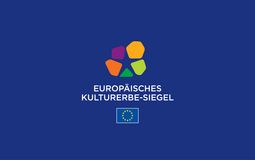European Heritage Label

Since 2014, the European Cultural Heritage Label has been awarded to sites that
- have a significant European symbolic value
- represent the common history of Europe
- promote the European values fundamental to coexistence in Europe.
At an EU ceremony on March 26th, 2018, the association of nine Leipzig music heritage sites together with the Leipziger Notenspur was awarded the European Cultural Heritage Label. According to the European jury, the Leipzig network of sites "represents the dynamic continuity of a special European tradition of music and civic engagement." It is a permanent distinction whose continuing eligibility is reviewed by the EU every four years.
Subjects of Leipzig's application
as a compound site with several partial sites:
- St. Thomas Church with St. Thomas Boys Choir
- St. Nicholas Church
- Old St. Nicholas School
- Leipzig Bach Archive in the Bose House
- University of Music and Theatre “Felix Mendelssohn Bartholdy“ (main building Grassistrasse)
- Mendelssohn House
- Schumann House
- Grieg Memorial Centre at CF Peters Publishing House
- Leipzig Gewandhaus
- Leipziger Notenspur (Leipzig Music Trail as a framework for the application and mediation network)
- Project “European Music Trails” (by Notenspur Leipzig e.V.)
The Leipziger Notenspur serves as an ideal and material bracket and as a mediation network.
History of the Leipzig Application
- 2006 - Proposal by Notenspur initiator W. Schneider to the city of Leipzig to seek an entry in the UNESCO World Heritage List with the authentic composer sites of the Leipziger Notenspur.
- 2007 - Formation of a UNESCO initiative from the citizens of Leipzig
- 2008 - Decision in principle by Leipzig City Council to support the UNESCO initiative
- 2008/2009 - Cooperation project of Brandenburg University of Technology Cottbus, Master's program "World Heritage Studies", Leipzig UNESCO Initiative and Leipzig University to investigate Leipzig's candidacy potential
- 2009, October - Formation of a committee consisting of the Leipzig UNESCO Initiative, the Leipzig Department of Culture and participating music institutions
- 2010 - Leipzig takes the lead in the UNESCO application process
- 2012 - Submission of Leipzig's application for the UNESCO World Heritage List "Leipziger Notenspur - Stätten europäischer Musikgeschichte".
- 2014 - Recommendation of the German Conference of Ministers of Education and Cultural Affairs not to submit the application for the UNESCO World Heritage List, but for the newly created European Cultural Heritage Label
- 2015 - Submission of the application for the European Cultural Heritage Label with nine Leipzig music heritage sites, the Leipziger Notenspur and the project "Europäische Notenspuren".
- 2016 - Nomination of this application by the Conference of Ministers of Culture as Germany's proposal and submission to the EU.
- 2017, December - Positive vote of the European jury on Leipzig's application.
- 2018, March 26th - Awarded the European Cultural Heritage Label by the EU Commission.
Background information
European Cultural Heritage Label sites in Germany
- Sites of the Peace of Westphalia: town halls in Münster and Osnabrück (awarded 2015).
- Hambach Castle (1832 Hambach Festival, founding event of the German democracy movement) (awarded 2015)
- Leipzig's music heritage sites (awarded 2018)
- Former Natzweiler Concentration Camp (France, French application) and its satellite camps in France and Germany (awarded 2018)
Focus of the European Cultural Heritage Label compared to the UNESCO World Heritage List
- While only monuments can be protected under the World Heritage List, the European Cultural Heritage Label can recognize as a strength the Leipzig connection between intangible music created in Leipzig and the associated material places where Leipzig composers and ensembles of world renown lived, worked and performed.
- In the case of the European Cultural Heritage Label, much greater importance is attached to cultural mediation for broad user groups and, in particular, to passing on the heritage to future generations. This is where the Notenspur project makes an impression with its intergenerational and innovative forms of communication (Little Leipzig Music Trail, Notenspur Night of Playing Music at Home, Leipziger Notenrad, etc.).
- The European Cultural Heritage Label honours European values that are important for our coexistence:
- In a Europe of Citizens, citizen initiative and citizen participation have a special significance. This is underlined by the long history of civic commitment to the development of music, which has been characteristic of the civic and musical city for centuries and is perpetuated by the development of the Notenspur project.
- Music connects us like a common "mother tongue". Everyone is "at home" there and it knows no "strangers". The pan-European musical-cultural exchange characteristic of Leipzig shows that diversity and commonality, national and European identity can complement each other fruitfully.
- For the award of the European Cultural Heritage Label, a great cultural tradition alone is not sufficient. With new activities ("projects"), it must be demonstrated that the awarded site is also of European attraction today and that innovative impulses for Europe emanate from it in the present. The 16 out of 25 applications rejected by the European expert commission in December 2017 failed not because of their great past, but because of the lack of distinctiveness and quality of the current European activities.
In its successful application, Leipzig contributed the project "Europäische Notenspuren" ("European Music Trails") by Notenspur Leipzig e.V.




